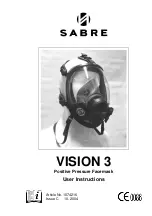
C-1
Appendix C. CSAT3 Measurement
Theory
C.1 Theory of Operation
C.1.1 Wind Speed
Each axis of the CSAT3 pulses two ultrasonic signals in opposite directions.
The time of flight of the first signal (out) is given by:
t
d
c u
o
a
=
+
(1)
and the time of flight of the second signal (back) is given by:
t
d
c u
b
=
-
a
(2)
where t
o
is the time of flight out along the transducer axis, t
b
is the time of
flight back, in the opposite direction, u
a
is the wind speed along the transducer
axis, d is the distance between the transducers, and c is the speed of sound.
The wind speed, u
a
, along any axis can be found by inverting the above
relationships, then subtracting Eq. (2) from (1) and solving for u
a
.
u
d
t
t
a
o
b
=
−
⎡
⎣
⎢
⎢
⎤
⎦
⎥
⎥
2
1
1
(3)
The wind speed is measured on all three non-orthogonal axis to give u
a
, u
b
, and
u
c
, where the subscripts a, b, and c refer to the non-orthogonal sonic axis.
The non-orthogonal wind speed components are then transformed into
orthogonal wind speed components, u
x
, u
y
, and u
z,
with the following:
u
u
u
A
u
u
u
x
y
z
a
b
c
⎡
⎣
⎢
⎢
⎢
⎤
⎦
⎥
⎥
⎥
=
⎡
⎣
⎢
⎢
⎢
⎤
⎦
⎥
⎥
⎥
(4)
where A is a 3 x 3 coordinate transformation matrix, that is unique for each
CSAT3 and is stored in ROM memory.
C.1.2 Temperature
The sonically determined speed of sound can be found from the sum of the
inverses of Eq. (1) and (2). The CSAT3 corrects online for the effect of wind
Summary of Contents for CSAT3
Page 2: ......
Page 56: ...Appendix A CSAT3 Orientation A 4 ...
Page 66: ...Appendix C CSAT3 Measurement Theory C 4 ...
Page 70: ...Appendix D SDM Communications and Long Signal Cables D 4 ...
Page 71: ......










































